15.5E: Ejercicios para la Sección 15.5
( \newcommand{\kernel}{\mathrm{null}\,}\)
En los ejercicios 1 - 8, evaluar las triples integrales∭Ef(x,y,z)dV sobre el sólidoE.
1. f(x,y,z)=z,B={(x,y,z)|x2+y2≤9,x≤0,y≤0,0≤z≤1}
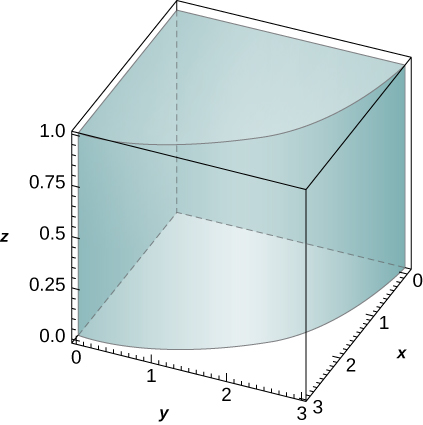
- Contestar
- 9π8
2. f(x,y,z)=xz2, B={(x,y,z)|x2+y2≤16, x≥0, y≤0, −1≤z≤1}
3. f(x,y,z)=xy, B={(x,y,z)|x2+y2≤1, x≥0, x≥y, −1≤z≤1}
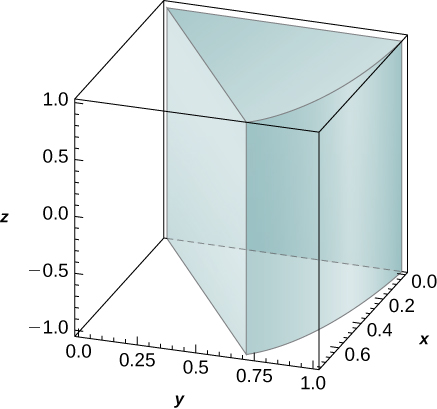
- Contestar
- 18
4. f(x,y,z)=x2+y2, B={(x,y,z)|x2+y2≤4, x≥0, x≤y, 0≤z≤3}
5. f(x,y,z)=e√x2+y2, B={(x,y,z)|1≤x2+y2≤4, y≤0, x≤y√3, 2≤z≤3}
- Contestar
- πe26
6. f(x,y,z)=√x2+y2, B={(x,y,z)|1≤x2+y2≤9, y≤0, 0≤z≤1}
7. a. DejarB ser una concha cilíndrica con radio interior radioa exteriorb, y alturac donde0<a<b yc>0. Supongamos que una funciónF definida enB puede expresarse en coordenadas cilíndricas comoF(x,y,z)=f(r)+h(z), dóndef yh son funciones diferenciables. Si∫baˉf(r)dr=0 yˉh(0)=0, dondeˉf yˉh son antiderivados def yh, respectivamente, muestran que∭BF(x,y,z)dV=2πc(bˉf(b)−aˉf(a))+π(b2−a2)ˉh(c).
b. Utilice el resultado anterior para mostrar∭B(z+sin√x2+y2)dx dy dz=6π2(π−2), dóndeB está una carcasa cilíndrica con radio interior2π, radioπ exterior y altura2.
8. a. DejarB ser una concha cilíndrica con radio interior radioa exteriorb y alturac donde0<a<b yc>0. Supongamos que una funciónF definida enB puede expresarse en coordenadas cilíndricas comoF(x,y,z)=f(r)g(θ)f(z), dóndef, g, yh son funciones diferenciables. Si∫ba˜f(r)dr=0, donde˜f es un antiderivado def, mostrar que∭BF(x,y,z)dV=[b˜f(b)−a˜f(a)][˜g(2π)−˜g(0)][˜h(c)−˜h(0)], donde˜g y˜h son antiderivados deg yh, respectivamente.
b. Utilice el resultado anterior para mostrar∭Bzsin√x2+y2dx dy dz=−12π2, dóndeB está una carcasa cilíndrica con radio interior2π, radioπ exterior y altura2.
En los ejercicios 9 - 12, los límites del sólidoE se dan en coordenadas cilíndricas.
a. Expresar la regiónE en coordenadas cilíndricas.
b. Convertir las coordenadas integrales∭Ef(x,y,z)dV a cilíndricas.
9. Eestá delimitado por el cilindro circular derechor=4sinθ, elrθ plano y la esferar2+z2=16.
- Contestar
-
a.E={(r,θ,z)|0≤θ≤π, 0≤r≤4sinθ, 0≤z≤√16−r2}
b.∫π0∫4sinθ0∫√16−r20f(r,θ,z)rdz dr dθ
10. Eestá delimitado por el cilindro circular derechor=cosθ, elrθ plano y la esferar2+z2=9.
11. Ese encuentra en el primer octante y está delimitado por el paraboloide circularz=9−3r2, el cilindror=√3 y el planor(cosθ+sinθ)=20−z.
- Contestar
-
a.E={(r,θ,z)|0≤θ≤π2, 0≤r≤√3, 9−r2≤z≤10−r(cosθ+sinθ)}
b.∫π/20∫√30∫10−r(cosθ+sinθ)9−r2f(r,θ,z)r dz dr dθ
12. Ese encuentra en el primer octante fuera del paraboloide circularz=10−2r2 y dentro del cilindror=√5 y está delimitado también por los planosz=20 yθ=π4.
En los ejercicios 13 - 16,E se dan la funciónf y región.
a. Expresar la regiónE y la funciónf en coordenadas cilíndricas.
b. Convertir la integral∭Bf(x,y,z)dV en coordenadas cilíndricas y evaluarla.
13. f(x,y,z)=x2+y2,E={(x,y,z)|0≤x2+y2≤9, x≥0, y≥0, 0≤z≤x+3}
- Contestar
-
a.E={(r,θ,z)|0≤r≤3, 0≤θ≤π2, 0≤z≤r cosθ+3},
f(r,θ,z)=1r cosθ+3b.∫30∫π/20∫r cosθ+30rr cosθ+3dz dθ dr=9π4
14. f(x,y,z)=x2+y2, E={(x,y,z)|0≤x2+y2≤4, y≥0, 0≤z≤3−x}
15. f(x,y,z)=x, E={(x,y,z)|1≤y2+z2≤9, 0≤x≤1−y2−z2}
- Contestar
-
a.y=r cosθ, z=r sinθ, x=z, E={(r,θ,z)|1≤r≤3, 0≤θ≤2π, 0≤z≤1−r2}, f(r,θ,z)=z;
b.∫31∫2π0∫1−r20zr dz dθ dr=356π3
16. f(x,y,z)=y, E={(x,y,z)|1≤x2+z2≤9, 0≤y≤1−x2−z2}
En los ejercicios 17 - 24, encuentra el volumen del sólidoE cuyos límites se dan en coordenadas rectangulares.
17. Eestá por encima delxy plano, dentro del cilindrox2+y2=1 y por debajo del planoz=1.
- Contestar
- π
18. Eestá debajo del planoz=1 y dentro del paraboloidez=x2+y2.
19. Eestá delimitado por el cono circularz=√x2+y2 yz=1.
- Contestar
- π3
20. Ese encuentra por encima delxy plano, abajoz=1, fuera del hiperboloidex2+y2−z2=1 de una hoja y dentro del cilindrox2+y2=2.
21. Ese encuentra dentro del cilindrox2+y2=1 y entre los paraboloides circularesz=1−x2−y2 yz=x2+y2.
- Contestar
- π
22. Ese encuentra dentro de la esferax2+y2+z2=1, por encima delxy plano y dentro del cono circularz=√x2+y2.
23. Ese encuentra fuera del cono circularx2+y2=(z−1)2 y entre los planosz=0 yz=2.
- Contestar
- 4π3
24. Ese encuentra fuera del cono circularz=1−√x2+y2, por encima delxy plano -plano, por debajo del paraboloide circular, y entre los planosz=0 yz=2.
25. [T] Utilice un sistema de álgebra computacional (CAS) para graficar el sólido cuyo volumen viene dado por la integral iterada en coordenadas cilíndricas∫π/2−π/2∫10∫rr2rdzdrdθ. Encuentra el volumenV del sólido. Redondea tu respuesta a cuatro decimales.
- Contestar
-
V=pi12≈0.2618
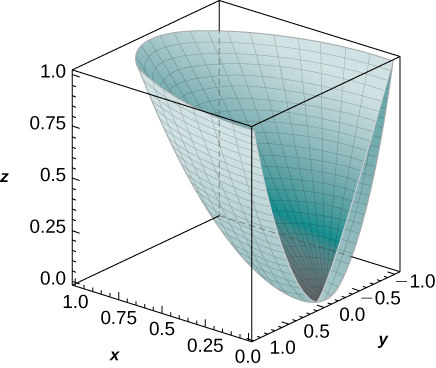
26. [T] Utilice un CAS para graficar el sólido cuyo volumen viene dado por la integral iterada en coordenadas cilíndricas∫π/20∫10∫rr4rdzdrdθ. Find the volume E of the solid. Round your answer to four decimal places.
27. Convert the integral ∫10∫√1−y2−√1−y2∫√x2+y2x2+y2xz dz dx dy into an integral in cylindrical coordinates.
- Answer
- ∫10∫π0∫rr2zr2 cosθdz dθ dr
28. Convert the integral ∫20∫y0∫10(xy+z)dz dx dy into an integral in cylindrical coordinates.
In exercises 29 - 32, evaluate the triple integral ∭Bf(x,y,z)dV over the solid B.
29. f(x,y,z)=1, B={(x,y,z)|x2+y2+z2≤90, z≥0}
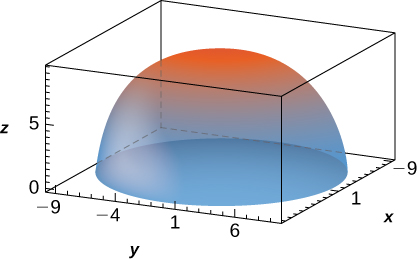
[Ocultar solución]
- Contestar
- 180π√10
30. f(x,y,z)=1−√x2+y2+z2, B={(x,y,z)|x2+y2+z2≤9, y≥0, z≥0}
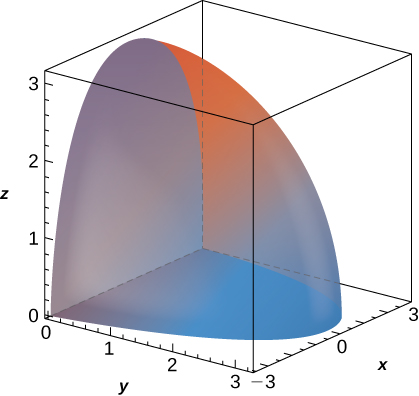
31. f(x,y,z)=√x2+y2, B is bounded above by the half-sphere x2+y2+z2=9 with z≥0 and below by the cone 2z2=x2+y2.
- Answer
- 81π(π−2)16
32. f(x,y,z)=√x2+y2, B is bounded above by the half-sphere x2+y2+z2=16 with z≥0 and below by the cone 2z2=x2+y2.
33. Show that if F(ρ,θ,φ)=f(ρ)g(θ)h(φ) is a continuous function on the spherical box B={(ρ,θ,φ)|a≤ρ≤b, α≤θ≤β, γ≤φ≤ψ}, then ∭BF dV=(∫baρ2f(ρ) dr)(∫βαg(θ) dθ)(∫ψγh(φ) sinφ dφ).
34. A function F is said to have spherical symmetry if it depends on the distance to the origin only, that is, it can be expressed in spherical coordinates as F(x,y,z)=f(ρ), where ρ=√x2+y2+z2. Show that ∭BF(x,y,z)dV=2π∫baρ2f(ρ)dρ, where B is the region between the upper concentric hemispheres of radii a and b centered at the origin, with 0<a<b and F a spherical function defined on B.
Use the previous result to show that ∭B(x2+y2+z2)√x2+y2+z2dV=21π, where B={(x,y,z)|1≤x2+y2+z2≤2, z≥0}.
35. Let B be the region between the upper concentric hemispheres of radii a and b centered at the origin and situated in the first octant, where 0<a<b. Consider F a function defined on B whose form in spherical coordinates (ρ,θ,φ) is F(x,y,z) = f(\rho)\cos \varphi. Show that if g(a) = g(b) = 0 and \displaystyle\int_a^b h (\rho) \, d\rho = 0, then \displaystyle\iiint_B F(x,y,z)\,dV = \frac{\pi^2}{4} [ah(a) - bh(b)], where g is an antiderivative of f and h is an antiderivative of g.
Use the previous result to show that \displaystyle \iiint_B = \frac{z \cos \sqrt{x^2 + y^2 + z^2}}{\sqrt{x^2 + y^2 + z^2}} \, dV = \frac{3\pi^2}{2}, where B is the region between the upper concentric hemispheres of radii \pi and 2\pi centered at the origin and situated in the first octant.
In exercises 36 - 39, the function f and region E are given.
a. Express the region E and function f in cylindrical coordinates.
b. Convert the integral \displaystyle \iiint_B f(x,y,z)\, dV into cylindrical coordinates and evaluate it.
36. f(x,y,z) = z; \space E = \big\{(x,y,z)\, | \,0 \leq x^2 + y^2 + z^2 \leq 1, \space z \geq 0\big\}
37. f(x,y,z) = x + y; \space E = \big\{(x,y,z)\, | \,1 \leq x^2 + y^2 + z^2 \leq 2, \space z \geq 0, \space y \geq 0\big\}
- Answer
-
a. f(\rho,\theta, \varphi) = \rho \space \sin \varphi \space (\cos \theta + \sin \theta), \space E = \big\{(\rho,\theta,\varphi)\, | \,1 \leq \rho \leq 2, \space 0 \leq \theta \leq \pi, \space 0 \leq \varphi \leq \frac{\pi}{2}\big\};
b. \displaystyle \int_0^{\pi} \int_0^{\pi/2} \int_1^2 \rho^3 \cos \varphi \space \sin \varphi \space d\rho \space d\varphi \space d\theta = \frac{15\pi}{8}
38. f(x,y,z) = 2xy; \space E = \big\{(x,y,z)\, | \,\sqrt{x^2 + y^2} \leq z \leq \sqrt{1 - x^2 - y^2}, \space x \geq 0, \space y \geq 0\big\}
39. f(x,y,z) = z; \space E = \big\{(x,y,z)\, | \,x^2 + y^2 + z^2 - 2x \leq 0, \space \sqrt{x^2 + y^2} \leq z\big\}
- Answer
-
a. f(\rho,\theta,\varphi) = \rho \space \cos \varphi; \space E = \big\{(\rho,\theta,\varphi)\, | \,0 \leq \rho \leq 2 \space \cos \varphi, \space 0 \leq \theta \leq \frac{\pi}{2}, \space 0 \leq \varphi \leq \frac{\pi}{4}\big\};
b. \displaystyle\int_0^{\pi/2} \int_0^{\pi/4} \int_0^{2 \space \cos \varphi} \rho^3 \sin \varphi \space \cos \varphi \space d\rho \space d\varphi \space d\theta = \frac{7\pi}{24}
In exercises 40 - 41, find the volume of the solid E whose boundaries are given in rectangular coordinates.
40. E = \big\{ (x,y,z)\, | \,\sqrt{x^2 + y^2} \leq z \leq \sqrt{16 - x^2 - y^2}, \space x \geq 0, \space y \geq 0\big\}
41. E = \big\{ (x,y,z)\, | \,x^2 + y^2 + z^2 - 2z \leq 0, \space \sqrt{x^2 + y^2} \leq z\big\}
- Answer
- \frac{\pi}{4}
42. Use spherical coordinates to find the volume of the solid situated outside the sphere \rho = 1 and inside the sphere \rho = \cos \varphi, with \varphi \in [0,\frac{\pi}{2}].
43. Use spherical coordinates to find the volume of the ball \rho \leq 3 that is situated between the cones \varphi = \frac{\pi}{4} and \varphi = \frac{\pi}{3}.
- Answer
- 9\pi (\sqrt{2} - 1)
44. Convert the integral \displaystyle \int_{-4}^4 \int_{-\sqrt{16-y^2}}^{\sqrt{16-y^2}} \int_{-\sqrt{16-x^2-y^2}}^{\sqrt{16-x^2-y^2}} (x^2 + y^2 + z^2) \, dz \, dx \, dy into an integral in spherical coordinates.
45. Convert the integral \displaystyle \int_0^4 \int_0^{\sqrt{16-x^2}} \int_{-\sqrt{16-x^2-y^2}}^{\sqrt{16-x^2-y^2}} (x^2 + y^2 + z^2)^2 \, dz \space dy \space dx into an integral in spherical coordinates.
- Answer
- \displaystyle\int_0^{\pi/2} \int_0^{\pi/2} \int_0^4 \rho^6 \sin \varphi \, d\rho \, d\phi \, d\theta
47. [T] Use a CAS to graph the solid whose volume is given by the iterated integral in spherical coordinates \displaystyle \int_{\pi/2}^{\pi} \int_{5\pi}^{\pi/6} \int_0^2 \rho^2 \sin \varphi \space d\rho \space d\varphi \space d\theta. Find the volume V of the solid. Round your answer to three decimal places.
- Answer
-
V = \frac{4\pi\sqrt{3}}{3} \approx 7.255

48. [T] Utilice un CAS para graficar el sólido cuyo volumen viene dado por la integral iterada en coordenadas esféricas como\displaystyle \int_0^{2\pi} \int_{3\pi/4}^{\pi/4} \int_0^1 \rho^2 \sin \varphi \space d\rho \space d\varphi \space d\theta. Encontrar el volumenV del sólido. Redondea tu respuesta a tres decimales.
49. [T] Utilice un CAS para evaluar la integral\displaystyle \iiint_E (x^2 + y^2) \, dV dondeE se encuentra por encima del paraboloidez = x^2 + y^2 y por debajo del planoz = 3y.
- Contestar
- \frac{343\pi}{32}
50. [T]
a. Evaluar la integral\displaystyle \iiint_E e^{\sqrt{x^2+y^2+z^2}}\, dV, dondeE está delimitada por esferas4x^2 + 4y^2 + 4z^2 = 1 yx^2 + y^2 + z^2 = 1.
b. Utilice un CAS para encontrar una aproximación de la integral anterior. Redondea tu respuesta a dos decimales.
51. Expresar el volumen del sólido dentro de la esferax^2 + y^2 + z^2 = 16 y fuera del cilindrox^2 + y^2 = 4 como integrales triples en coordenadas cilíndricas y coordenadas esféricas, respectivamente.
- Contestar
- \displaystyle \int_0^{2\pi}\int_2^4\int_{−\sqrt{16−r^2}}^{\sqrt{16−r^2}}r\,dz\,dr\,dθy\displaystyle \int_{\pi/6}^{5\pi/6}\int_0^{2\pi}\int_{2\csc \phi}^{4}\rho^2\sin \rho \, d\rho \, d\theta \, d\phi
52. Expresar el volumen del sólido dentro de la esferax^2 + y^2 + z^2 = 16 y fuera del cilindrox^2 + y^2 = 4 que se ubica en el primer octante como integrales triples en coordenadas cilíndricas y coordenadas esféricas, respectivamente.
53. La potencia emitida por una antena tiene una densidad de potencia por unidad de volumen dada en coordenadas esféricas porp(\rho,\theta,\varphi) = \frac{P_0}{\rho^2} \cos^2 \theta \space \sin^4 \varphi, dondeP_0 es una constante con unidades en vatios. La potencia total dentro de una esferaB der metros de radio se define como\displaystyle P = \iiint_B p(\rho,\theta,\varphi) \, dV. Encontrar la potencia totalP.
- Contestar
- P = \frac{32P_0 \pi}{3}vatios
54. Utilice el ejercicio anterior para encontrar la potencia total dentro de una esferaB de radio 5 metros cuando la densidad de potencia por unidad de volumen viene dada porp(\rho, \theta,\varphi) = \frac{30}{\rho^2} \cos^2 \theta \sin^4 \varphi.
55. Una nube de carga contenida en una esferaB der centímetros de radio centrada en el origen tiene su densidad de carga dada porq(x,y,z) = k\sqrt{x^2 + y^2 + z^2}\frac{\mu C}{cm^3}, dondek > 0. El cargo total contenido enB es dado por\displaystyle Q = \iiint_B q(x,y,z) \, dV. Encuentra el cargo totalQ.
- Contestar
- Q = kr^4 \pi \mu C
56. Utilice el ejercicio anterior para encontrar la nube de carga total contenida en la esfera unitaria si la densidad de carga esq(x,y,z) = 20 \sqrt{x^2 + y^2 + z^2} \frac{\mu C}{cm^3}.

